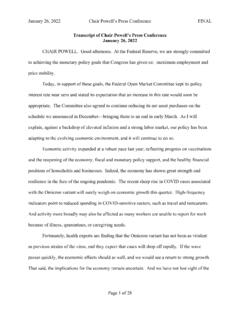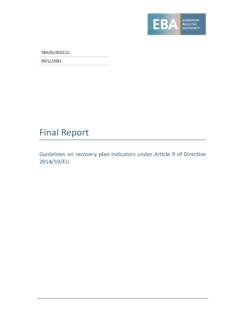Transcription of Brief 1: Overview of Policy Evaluation
1 National Center for Injury Prevention and ControlThis Brief provides a definition of Policy Evaluation , including a description of the Evaluation framework used and a definition of Policy . It also presents information about the general value and potential challenges of conducting Policy PolicyThe CDC definition of Policy is a law, regulation, procedure, administrative action, incentive or voluntary practice of governments and other institutions. 1 Policies generally operate at the systems level and can influence complex systems in ways that can improve the health and safety of a population. A Policy approach can be a cost-effective way to create positive changes in the health of large portions of the population. There are several types of Policy , each of which can operate at different levels (national, state, local, or organizational)2 Legislative policies are laws or ordinances created by elected representatives.
2 Regulatory policies include rules, guidelines, principles, or methods created by government agencies with regulatory authority for products or services. Organizational policies include rules or practices established within an agency or Is Policy Evaluation ?3 Policy Evaluation applies Evaluation principles and methods to examine the content, implementation or impact of a Policy . Evaluation is the activity through which we develop an understanding of the merit, worth, and utility of a Evaluation FrameworkWhile there are a variety of different approaches to Evaluation , this set of briefs utilize the six-step CDC Framework for Evaluation in Public Health, as shown in Figure Framework outlines an ongoing process comprising six steps of program These six steps are also applicable to Policy Evaluation and provide a guide for implementing a thorough Evaluation .
3 The remaining briefs each discuss the implementation of one or more of these steps. Figure 2 illustrates which steps are discussed in each 2, 6, and 7 discuss the steps as they apply to all types of Policy Evaluation , whereas Briefs 3, 4, and 5 discuss Step 3 (focusing the Evaluation design) as it applies to the specific types of Policy CDC, Office of the Associate Director for Policy . (2011). Definition of Policy . PDF available upon request; please contact CDC, Office of the Associate Director for Policy . (2011). Definition of Policy . PDF available upon request; please contact Her Majesty s Treasury. (2011). The magenta book: Guidance for Evaluation . London, UK: Author. Retrieved from CDC, Office of the Associate Director for Program. (2012, September). A framework for program Evaluation . Retrieved from 1: Overview of Policy Evaluation Policy Evaluation uses a range of research methods to systematically investigate the effectiveness of Policy interventions, implementation and processes, and to determine their merit, worth, or value in terms of improving the social and economic conditions of different stakeholders.
4 3 Step by Step Evaluating Violence and Injury Prevention PoliciesStep by Step Evaluating Violence and Injury Prevention Policies2 Figure 2. The Briefs in Relation to the Steps in the CDC Evaluation Framework(1) Engaging Stakeholders(2) Describing the Program or Policy (3) Focusing the Evaluation (4) Gather Credible Evidence(5) Justify Conclusions(6) Ensure Use and Lessons LearnedBrief 2 Brief 3 Brief 4 Brief 5 Brief 6 Brief 7 Standards for Conducting Evaluation The Framework also includes the following four categories of standards for conducting Evaluation to help guide choices along the process:Utility: Who wants the Evaluation results and for what purpose?Feasibility: Are the Evaluation procedures practical, given the time, resources, and expertise available?Propriety: Is the Evaluation being conducted in a fair and ethical way?Accuracy: Are approaches at each step accurate, given stakeholder needs and Evaluation purpose?
5 Policy Evaluation Versus Program EvaluationAlthough Policy Evaluation and program Evaluation have many similarities, there are some important differences as well. Some of these differences include: The level of analysis required ( , system or community level for Policy Evaluation ; program level for program Evaluation ).The degree of control and clear boundaries may be more challenging with Policy Evaluation . The ability to identify an equivalent comparison community may be more challenging with Policy Evaluation . The scale and scope of data collection may be greater with Policy Evaluation . Policy Evaluation may require increased emphasis on the use of surveillance and administrative data. The type and number of stakeholders involved may differ. Why Is Policy Evaluation Important?Developing and implementing Policy strategies is important in addressing injury and violence prevention at the population level.
6 Although Policy has been used effectively in some areas of injury and violence prevention, Step by Step Evaluating Violence and Injury Prevention Policies3policy strategies in some areas lack a sufficient evidence base. Policy Evaluation , like all Evaluation , can serve important purposes along the entire chain of the Policy process, including1: Evaluation Within the Policy ProcessIt is important to understand how Policy Evaluation fits into the larger Policy process. Understanding this context provides an increased understanding of why Policy Evaluation is critical to advancing the field of Policy . Although there are many theories regarding the Policy process and mechanisms of Policy change, the Policy change process is often conceptualized in several key stages as depicted on the top row of Figure Evaluation is an integral part of each step in the Policy process.
7 Although these steps are laid out in a row, in reality, the steps are circular in nature. The three main types of Evaluation , shown in the bottom row of Figure 3, each focus on a different phase of the Policy process5: Policy content Evaluation , Policy implementation Evaluation , and Policy impact Evaluation . Figure 3 illustrates the relationship between the main stages of the Policy process and the three types of Evaluation . Evaluating Policy Content: Does the content clearly articulate the goals of the Policy , its implementation and the underlying logic for why the Policy will produce intended change? Evaluating the development of a Policy helps to understand the context, content, and Policy Implementation: Was the Policy implemented as intended? The implementation of a Policy is a critical component in understanding its effectiveness. Evaluation of Policy implementation can provide important information about the barriers to and facilitators of implementation and a comparison between different components or intensities of implementation.
8 Evaluating Policy Impact: Did the Policy produce the intended outcomes and impact? Within injury prevention, the intended impact may be a reduction in injuries or severity of injuries. However, it is important to evaluate short-term and intermediate outcomes as type of Evaluation selected depends on many factors, and often more than one type of Evaluation will be needed. Each type of Evaluation can provide valuable information for the planning and interpretation of the other types of Evaluation (content, implementation, and impact) in addition to uncovering unintentional However, it is critical for each Evaluation to be focused so the most appropriate design and methodology is The team can develop an overarching set of Evaluation questions and then select specific Evaluation questions and methods for each particular phase. Appendix A and Appendix B provide examples of the planning, implementation, and dissemination of a Policy Evaluation .
9 5 Brownson, R. C., Royer, C., Chriqui, J. F., & Stamatakis, K. A. (2009). Understanding evidence-based public health Policy . American Journal of Public Health, 99, 1576 MacDonald, G., Starr, G., Schooley, M., Yee, S. L., Klimowksi, K., & Turner, K. (2001). Introduction to program Evaluation for comprehensive tobacco control programs. Atlanta, GA: Centers for Disease Control and Prevention. Retrieved from Policy development. Documenting and informing implementation. Assessing support and compliance with existing impacts and value of a Policy . Informing an evidence base. Informing future policies. Providing accountability for resources invested. Step by Step Evaluating Violence and Injury Prevention Policies4 Policy Evaluation ChallengesWhile all evaluations encounter challenges, some are particularly relevant to Policy Evaluation , and some of these are listed below.
10 Many of these challenges can be easily addressed by using an appropriate design, indicators, and methods. Specific solutions to many of these challenges are provided in Briefs 2 7. In addition, Appendix C provides an Overview of the challenges and potential solutions when conducting Policy Policy Evaluation ChallengesLack of resources or clear responsibility for evaluationLack of strong evidence base to support Policy Fear of Evaluation and lack of familiarity with Policy Evaluation methodsExternal and contextual factors such as economic conditions or public awareness Lack of control over Policy implementation Access to appropriate data Rapid pace of Policy Lack of appropriate measures Political scrutiny and desire for quick production of results Difficulty in identifying appropriate comparison communitiesAdditional ResourcesThe Magenta Book: Guidance for Evaluation (Her Majesty s Treasury).












